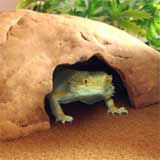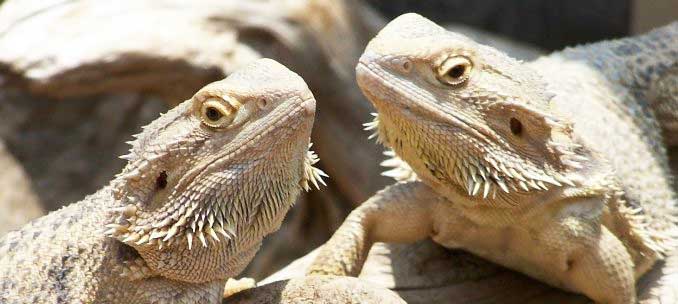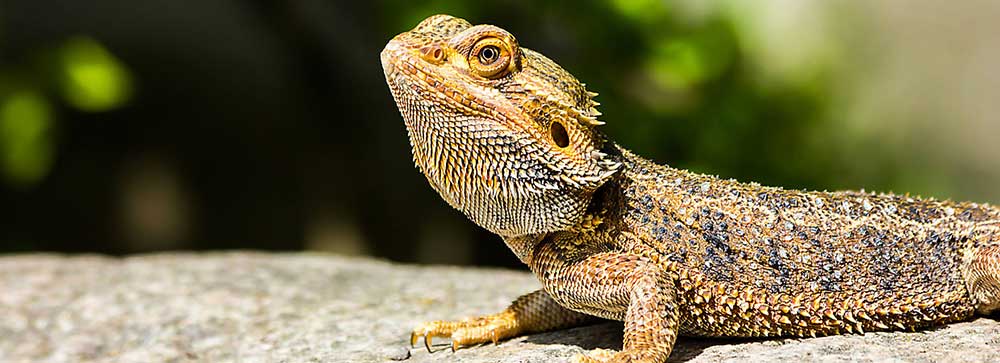Bearded Dragon
How to properly look after these sun-bathing pets
The bearded dragon’s scientific name is Pogona Vitticeps. They are medium sized lizards generally 30-60cm length from their heads to the tip of their tail.
Bearded dragons are only naturally found in Australian deserts and mostly in the southeastern Northern Territory and the eastern half of South Australia. Their habitats include woodlands, savannahs and deserts.
Tank Lighting
Being desert-dwellers, bearded dragons rely on sunlight to stay healthy, therefore, in the home enclosure, a well-lit room isn’t enough for them. For your bearded dragon to receive the right amount of light it needs UVA/UVB fluorescent light exposure for 12-14 hours each day. A basking light is also recommended for warmth, so make sure both lights will be able to fit in the enclosure.
The most recommended full spectrum light is the Reptisun full spectrum light. It will provide all the UV rays that your bearded dragon will need to remain healthy.
Tank Heating
Again, bearded dragons come from a desert environment which means they like HOT temperatures. They need temperatures between 29 C and 43 C.
Make sure to monitor both the temperature and humidity of your beardies enclosure to make sure it matches their habitat as closely as possible.
Do NOT use electrically heated rocks as they can burn and injure bearded dragons.
Choosing a Basking Light (Heat Lamp)
A heat lamp focuses the heat into one specific part of the enclosure and its very important to get a good quality heat lamp.
- Do not use a regular house light-bulb
- Keep on the 10+ hours each day and they will get very hot so best to have some sort of safe guard around the lamp to protect yourself and the beardies.
- The heat may cause lower quality bulbs to burn out quickly and some to explode.
Enclosure Bedding/Flooring
Flooring is essential for your enclosure. Choose something like reptile carpet, newspaper, paper towels, butcher paper or artificial grass.
Loose flooring is not recommended i.e sand, woodchips or pebbles because they can accidentally ingest them which cause impaction - a serious issue to be avoided at all costs.
 Reptile Hides and Set Up
Reptile Hides and Set Up
Bearded dragons need privacy so having a hide-away gives them a place to feel secure as well as seek shade from the light. Use something that is found/resembles something found in nature like a rock perhaps, or even attempt to make something.
Bearded dragons love to climb and perch on various objects to bathe in sunlight. Using a basking platform - something that will naturally obtain some heat from the heat lamp i.e a rock, branch or drift wood - your beardie can climb and bathe in the sunlight and embrace the heat.
Diet & Nutrition
Bearded dragons are omnivores, which means they will eat both insects and vegetables.
Your beardies diet will depend on age:
- Younger bearded dragons will eat 80% insects and 20% vegetables
- Adult bearded dragons will eat 20% insect and 80% vegetables.
- Make sure the food given to the bearded dragon is no bigger than the gap between their eyes otherwise your beardie has a possible chance of choking or injuring itself.

Feeding Young Bearded Dragons
Young bearded dragons require more insects than fruit or vegetables because they grow quickly. Feed as many insects as they can eat within the space a 10-15minute period three times a day. Leave a small bowl of fruit and vegetables for them during the day.
Feeding Adult Bearded Dragons
Adult bearded dragons will eat far less insects than younger dragons. Feeding time is once per day, giving them as many insects as they will eat in a 15-minute period. Also, can leave a bowl of fruit and vegetables for them during the day.
Insects for Bearded Dragons
Bearded dragons can eat almost any bug. The ones listed below are fine for them to consume but if there's another type you would like to feed them, please research it to determine whether it's ok for your Beardie to eat.
- Black soldier fly larvae
- Butterworms
- Crickets
- Dubia roaches
- Earthworms
- Locusts
- Redworms
Plants, Vegetables and Fruit
Plants are a major staple for their diets, they contain vitamins and minerals that bearded dragons need to keep healthy. Below is a list of vegetables that are safe for your dragon. Make sure you research whether any other fruit of vegetable you wish to give them is safe.
- Squash
- Collard greens
- Endive
- Mustard greens
- Turnip greens
- Apples
- Melon
- Prickly pears
- Strawberries
Insects, Plants, Fruits and Vegetables to Avoid
- Avocados
- Fireflies and other bugs that glow
- Insects captured in the wild
- Lettuce
- Spinach
- Poisonous plants

16343